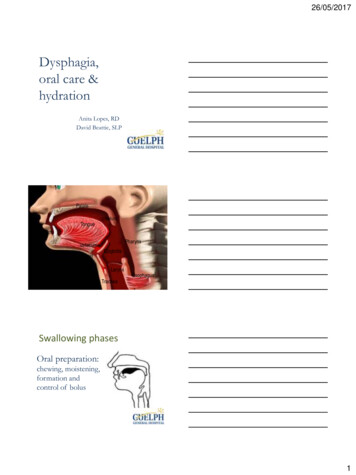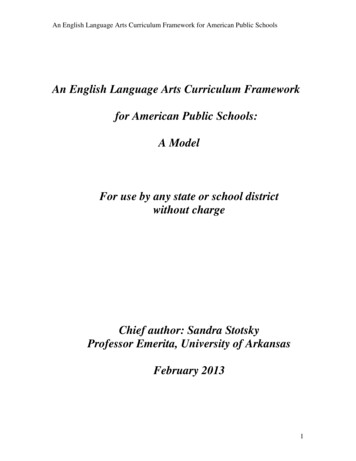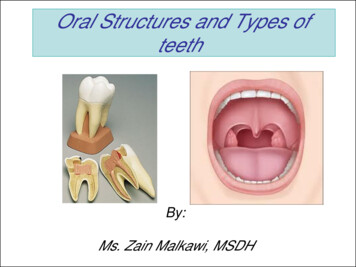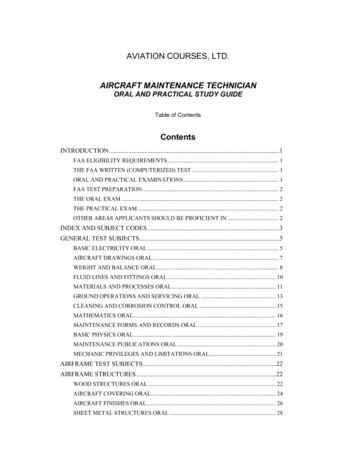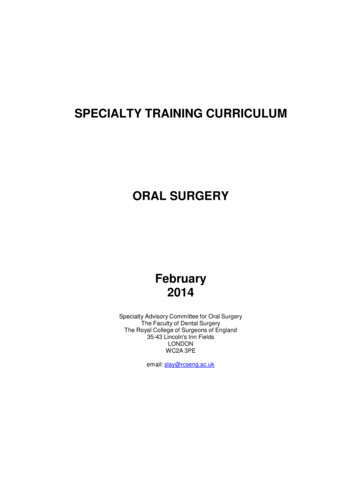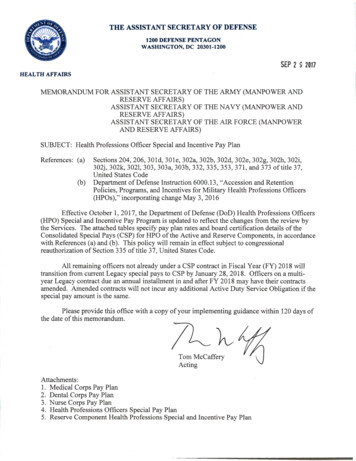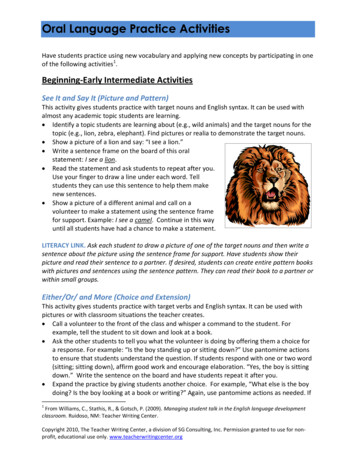
Transcription
Oral Language Practice ActivitiesHave students practice using new vocabulary and applying new concepts by participating in oneof the following activities1.Beginning-Early Intermediate ActivitiesSee It and Say It (Picture and Pattern)This activity gives students practice with target nouns and English syntax. It can be used withalmost any academic topic students are learning. Identify a topic students are learning about (e.g., wild animals) and the target nouns for thetopic (e.g., lion, zebra, elephant). Find pictures or realia to demonstrate the target nouns. Show a picture of a lion and say: “I see a lion.” Write a sentence frame on the board of this oralstatement: I see a lion. Read the statement and ask students to repeat after you.Use your finger to draw a line under each word. Tellstudents they can use this sentence to help them makenew sentences. Show a picture of a different animal and call on avolunteer to make a statement using the sentence framefor support. Example: I see a camel. Continue in this wayuntil all students have had a chance to make a statement.LITERACY LINK. Ask each student to draw a picture of one of the target nouns and then write asentence about the picture using the sentence frame for support. Have students show theirpicture and read their sentence to a partner. If desired, students can create entire pattern bookswith pictures and sentences using the sentence pattern. They can read their book to a partner orwithin small groups.Either/Or/ and More (Choice and Extension)This activity gives students practice with target verbs and English syntax. It can be used withpictures or with classroom situations the teacher creates. Call a volunteer to the front of the class and whisper a command to the student. Forexample, tell the student to sit down and look at a book. Ask the other students to tell you what the volunteer is doing by offering them a choice fora response. For example: “Is the boy standing up or sitting down?” Use pantomime actionsto ensure that students understand the question. If students respond with one or two word(sitting; sitting down), affirm good work and encourage elaboration. “Yes, the boy is sittingdown.” Write the sentence on the board and have students repeat it after you. Expand the practice by giving students another choice. For example, “What else is the boydoing? Is the boy looking at a book or writing?” Again, use pantomime actions as needed. If1From Williams, C., Stathis, R., & Gotsch, P. (2009). Managing student talk in the English language developmentclassroom. Ruidoso, NM: Teacher Writing Center.Copyright 2010, The Teacher Writing Center, a division of SG Consulting, Inc. Permission granted to use for nonprofit, educational use only. www.teacherwritingcenter.org
Oral Language Practice Activities students respond with one word (looking), affirm good work and encourage elaboration.“Yes, the boy is looking at a book.” Write the sentence on the board and have studentsrepeat it after you.Read the two sentences aloud: “The boy is sitting down. The boy is looking at a book.” Writethe sentences on the board and have students repeat them after you.LITERACY LINK. Have students copy the sentences on a piece of paper and then draw a pictureto illustrate them. Have students show their picture and read their sentences to a partner.Sequence of Events (TPR)This activity gives students practice with target nouns and verbs as well as sequence of events.It can be used with pictures, with classroom situations the teacher creates, or with classroomroutines students need to learn. Identify a situation (e.g., going to a museum on a school bus) in which a series of actionslogically occurs in a particular sequence. Write out the actions on the board. Point to andread the actions as you act out the six-line sequence.Going to a Museum on a School BusGet on the bus.Look for a seat.Sit down.Ride to the museum.Get off of the bus.Pay your money at the museum entrance. Act out and read each action again. Call on volunteers to act out the action as you say it.Then call on other volunteers to give the commands to the other students.LITERACY LINK. Ask students to make a mini-book of the sequence ofevents. They can copy the sequenced statements you wrote on theboard and then draw a picture to illustrate each statement.Get on the bus.Students can read their stories to a partner or within small groups.Copyright 2010, The Teacher Writing Center, a division of SG Consulting, Inc. Permission granted to use for nonprofit, educational use only. www.teacherwritingcenter.org
Oral Language Practice ActivitiesFollow the Pattern (Structured Talk)This activity can be used to practice verb tenses, adjective placement, plurals, or othergrammatical forms. Organize students into small groups. Give students a pattern to follow. For example, haveeach student say three sentences that include an adjective before a noun. Model this forstudents first: I have a black cat. I live in a small house. I like sweet foods. Have each student in the group practice the pattern by creating three original sentences.Then change the pattern. For example, have students say a sentence in the past tense andthen a sentence in the future tense: Yesterday I walked to school. Tomorrow I am going toride to school. Continue with other patterns. As an extension, have a student in the group create a patternand have other group members try to figure out what the pattern is by following it. Forexample, the student creating the pattern may say: I have a pen. You have two pens. I havea book. You have two books. I have a watch. You have two watches. The student whofigures out the pattern continues: I have a sister. You have two sisters. and so forth.LITERACY LINK. After oral practice, have students write the sentences they created with help asneeded.Intermediate-Advanced ActivitiesRelay Talk (One-on-One Communication)This activity gives students practice expressing themselves orally in unstructured discourse. Itcan be used with any academic topic or with classroom situations the teacher creates. Organize students into two equal lines with each student facing a partner. Designate one line as the moving line while the other line is the non-moving line. Explain to students that you will ask a question and give them two minutesto discuss it with the person immediately across from them in theother line. Example: Talk to your partner about the relationshipbetween the colonists and the American Indians living in NorthAmerica. Tell students when you say “time is up,” the first person in the“moving line” will go to the end of the line while everyone inthat line will move one space to the left or right and face a newpartner and a new question. Example: Talk to your partnerabout why some of the American colonists wanted independencefrom Great Britain. Have students discuss each question with two partners. Repeat the process with 3-4questions.LITERACY LINK. Engage the entire class in a discussion of one of the questions studentsdiscussed. For example, ask them to create a chart listing the reasons for independence fromCopyright 2010, The Teacher Writing Center, a division of SG Consulting, Inc. Permission granted to use for nonprofit, educational use only. www.teacherwritingcenter.org
Oral Language Practice ActivitiesGreat Britain. Have students write a paragraph or short essay about the topic. Call on studentsto read excerpts of their writing.3-2-1 GO! (Structured Questioning)This activity gives students practice expressing themselves orally in structured discourse. It canbe used with any academic topic or with classroom situations the teacher creates. Write on the board three open-ended questions about a topic, following this pattern: Sharethree examples of habitats. Talk about two ways that an animal adapts to its habitat.Discuss one way that human beings adversely affect animals’ habitats. Review the questions and ask students to listen carefully as you say: 3, 2, 1, GO! Organize students into small groups. Ask each group to take about five minutes to answerthe questions. Call on groups to share one statement for each of the questions.LITERACY LINK. Ask students to write a paragraph about the third question and then to sharetheir paragraph with the other members of their small group.Data Hunt (Structured Questioning)This activity gives students practice expressing themselves orally in structured discourse. It canbe used with any academic topic and/or as a way to encourage social language (as in theexample below). Ask students to divide a piece of paper into three columns. Write column headings on the board for all three columns and the tasks for columns oneand two. See the example. Have students copy the headings and tasks (columns one andtwo) on their paper. They will interact with their classmates to come up with responses forcolumn three.Find someonewho knows how toride a bicycle:(student’sname)takes the busto school:(student’sname)Ask the person The person I talked to said the benefits of riding a bicycle rather thandriving in a carriding a bicycle is good for theenvironment and good exercisewhat kinds of things people do on theschool buson the bus people talk to friends, dohomework, and look out the window and so forthCopyright 2010, The Teacher Writing Center, a division of SG Consulting, Inc. Permission granted to use for nonprofit, educational use only. www.teacherwritingcenter.org
Oral Language Practice Activities Give students a set amount of time to find and interact with a different person tocomplete each row.Then call on students to tell what they learned, using complete sentences. Example:knows how to ride a bicycle. I asked him/her to talk about the benefits ofriding a bicycle rather than driving in a car. He/she said riding a bicycle is good forthe environment and good exercise.LITERACY LINK. Ask students to write a complete sentence in response to one (or more) of thequestions.What Is It? (Oral Description)This activity gives students practice describing people, places, and things. Have each student draw a picture of a person, place or thing. Alternatively, students canprint clip art or cut a picture from a magazine. Organize students in pairs. Students should not let theirpartner see their picture. Have students take turnsdescribing their picture to their partner. Example: Thereare four different types of fruit in a bowl. There are threebananas. There is one apple. And so forth. The partnershould draw what he/she hears being described. When both students have finished describing theirpictures, have them compare the original picture with thepicture that was drawn and discuss any discrepancies.LITERACY LINK. Have students write a paragraph describing one of the pictures and attach thepicture to the paragraph.Copyright 2010, The Teacher Writing Center, a division of SG Consulting, Inc. Permission granted to use for nonprofit, educational use only. www.teacherwritingcenter.org
to ensure that students understand the question. If students respond with one or two word (sitting; sitting down), affirm good work and encourage elaboration. "Yes, the boy is sitting down." Write the sentence on the board and have students repeat it after you. Expand the practice by giving students another choice.

